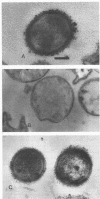Abstract
Strains of Vibrio vulnificus biotype 2, isolated from internal organs of diseased European eels as pure cultures of opaque cells, together with some reference strains from Japanese eels, were used in this study. Spontaneous translucent-phase variants were obtained from the corresponding parent strains and compared for a variety of phenotypic traits related to virulence for eels. The rate of colony dissociation from opaque to translucent cells was higher (around 10(-2)) than that observed for translucent to opaque cells (10(-3) to 10(-4)). Electron microscopy with ruthenium red revealed the presence of a capsule of variable thickness on opaque cells, whereas translucent-type colonies had no observable capsular materials. No differences in plasmid profiles were detected between the two cell types so that plasmids do not seem to be implicated in the mechanism of phase shift of biotype 2 strains. No apparent difference in outer membrane protein and lipopolysaccharide patterns could be observed between the cell types. Both isogenic morphotypes were able to grow in eel serum and minimal medium supplemented with ethylenediamine di(O-hydroxyphenyl-acetic acid) or transferrin. Therefore, the presence of capsule was not required for the acquisition of iron from iron chelators or for resistance to serum bactericidal action. Both morphotypes were highly virulent for elvers, although the 50% lethal dose for translucent cells was higher than that for the corresponding opaque cells. The latter observation, together with the overall data, suggests that the production of capsular materials by biotype 2 of V. vulnificus is not essential for the development of vibriosis in eels, at least when cells are injected intraperitoneally.
Full text
PDF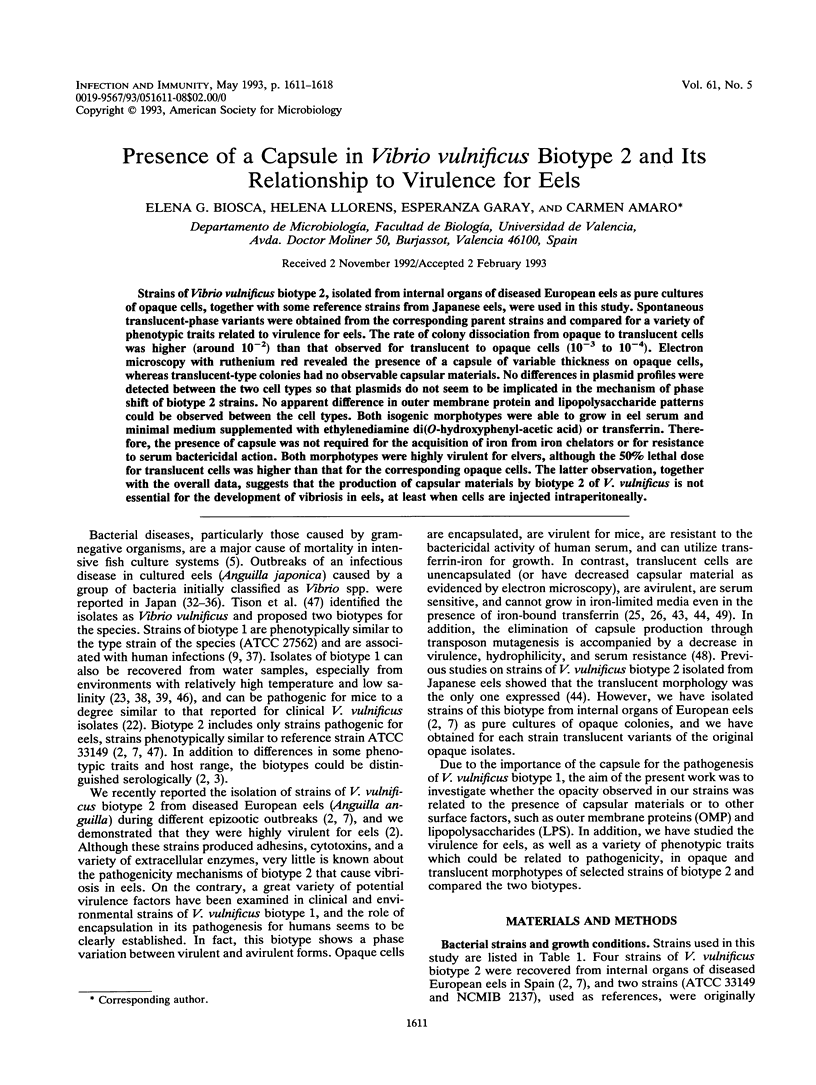
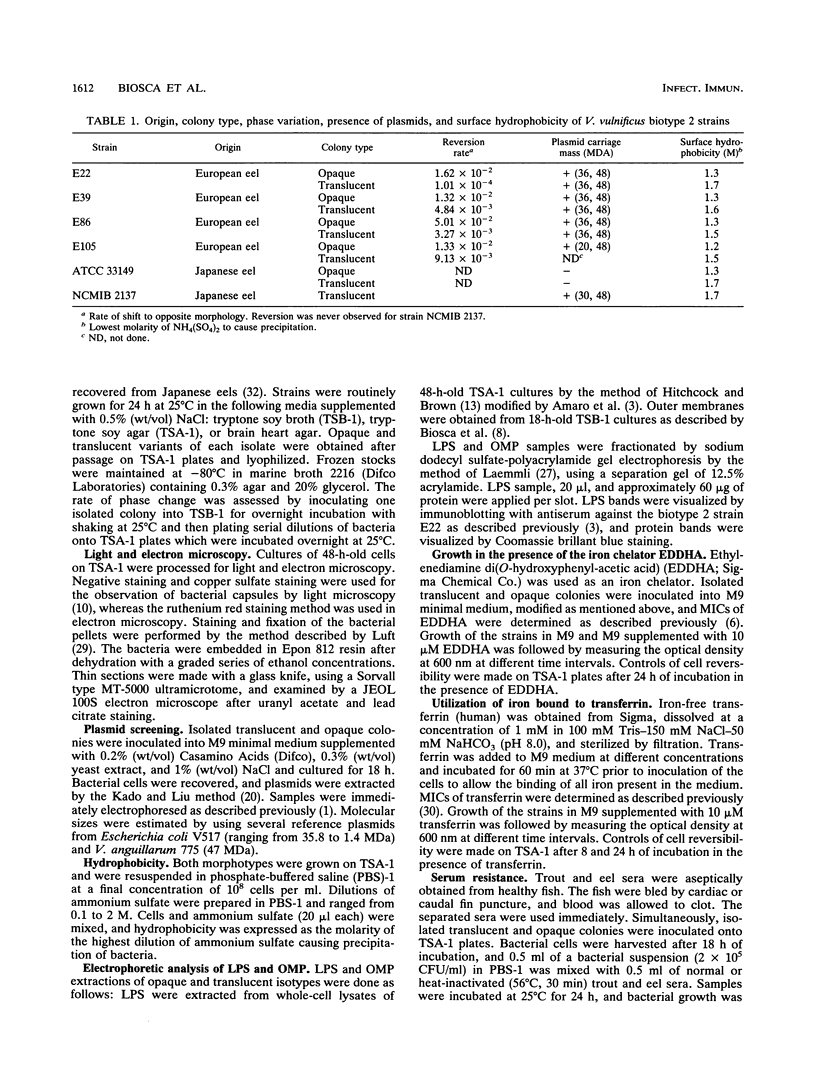
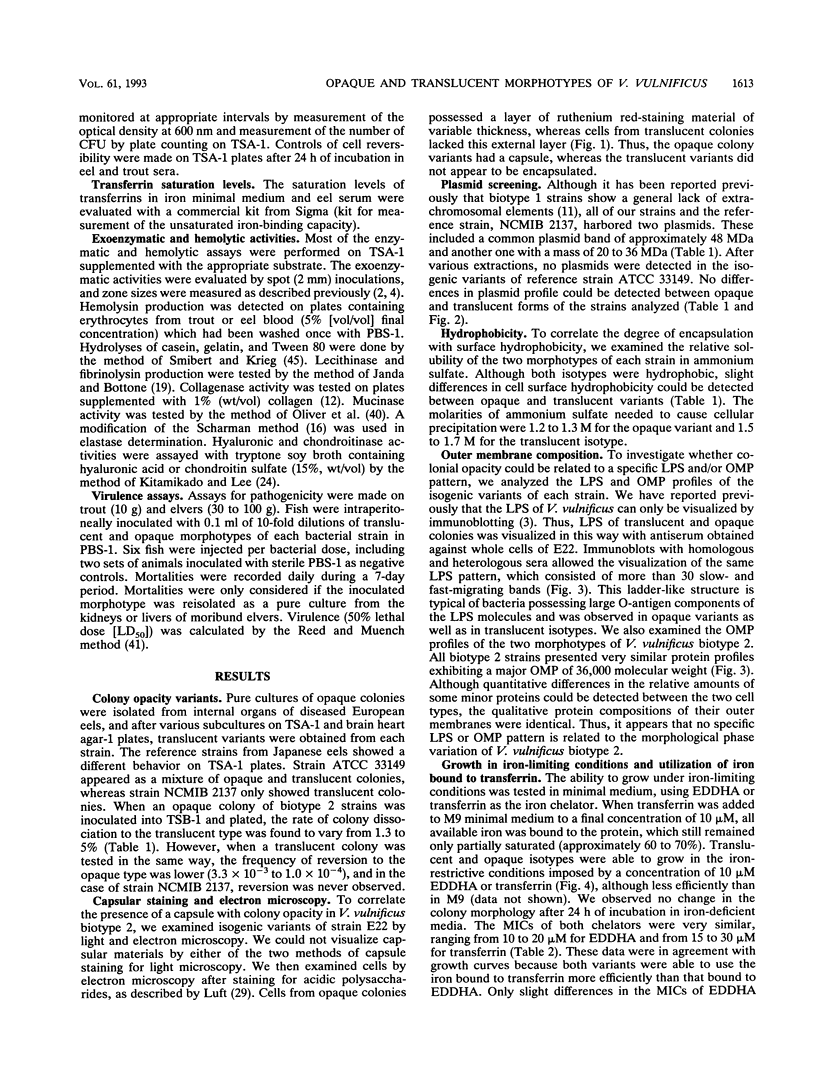
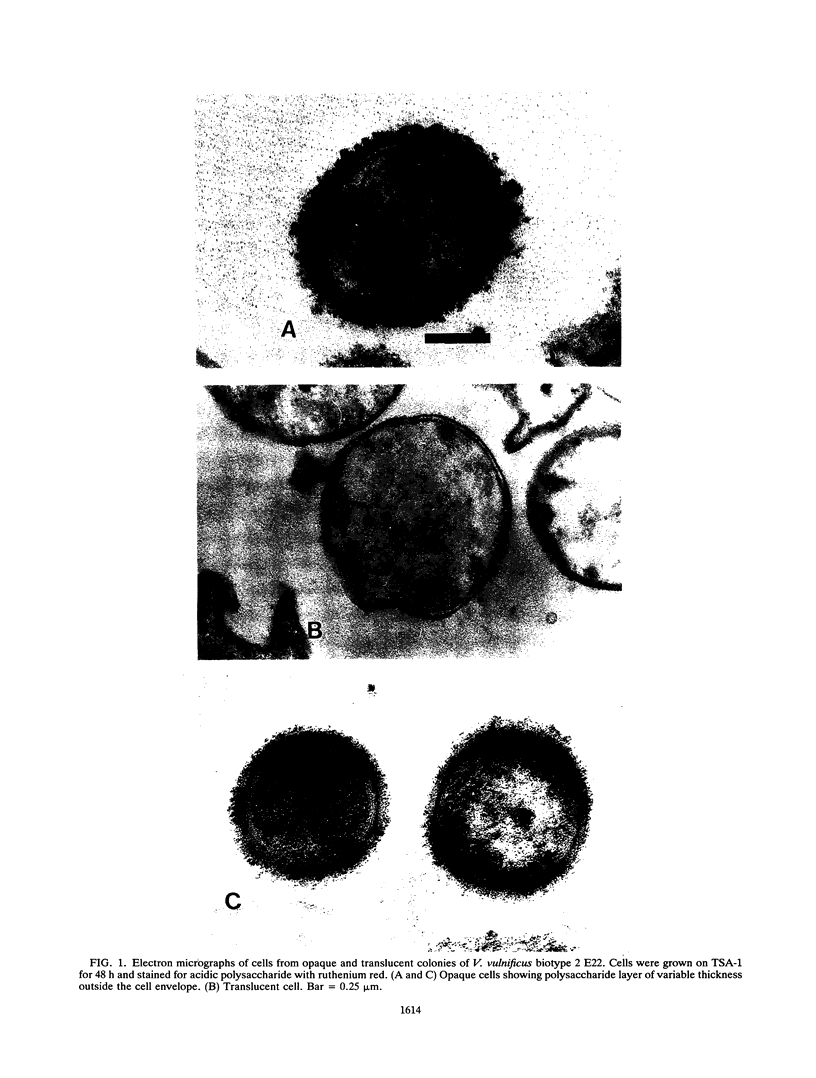
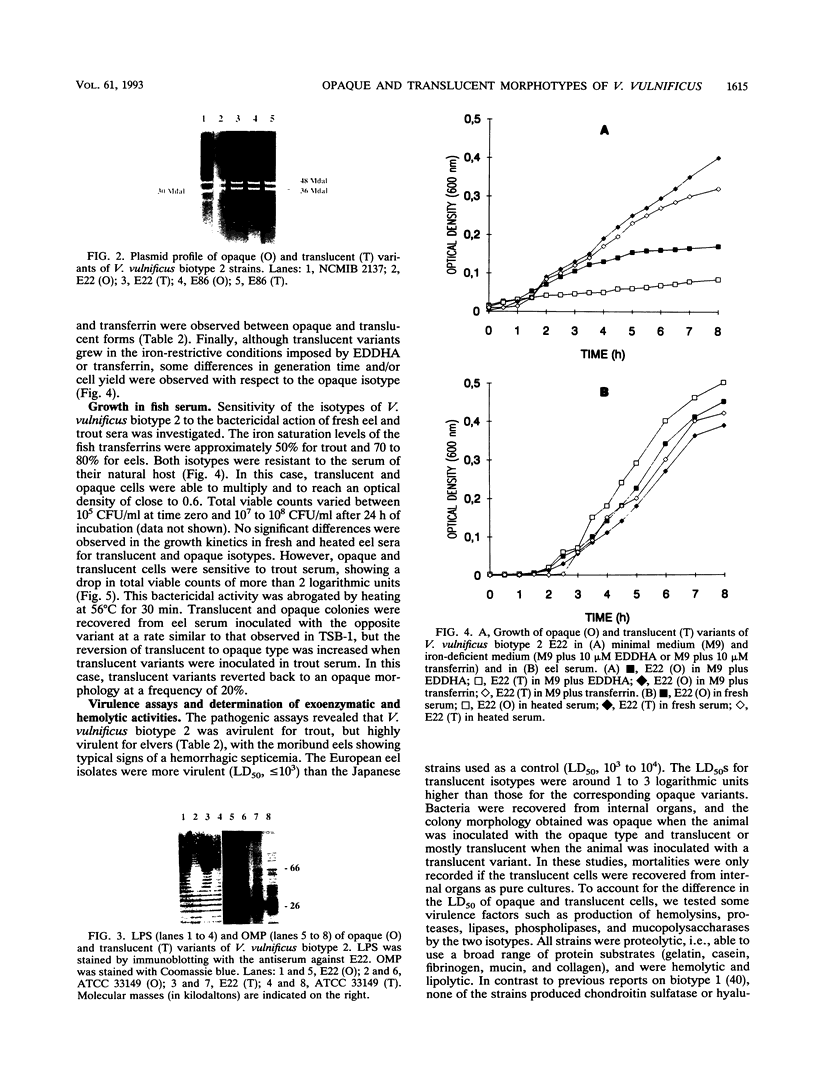
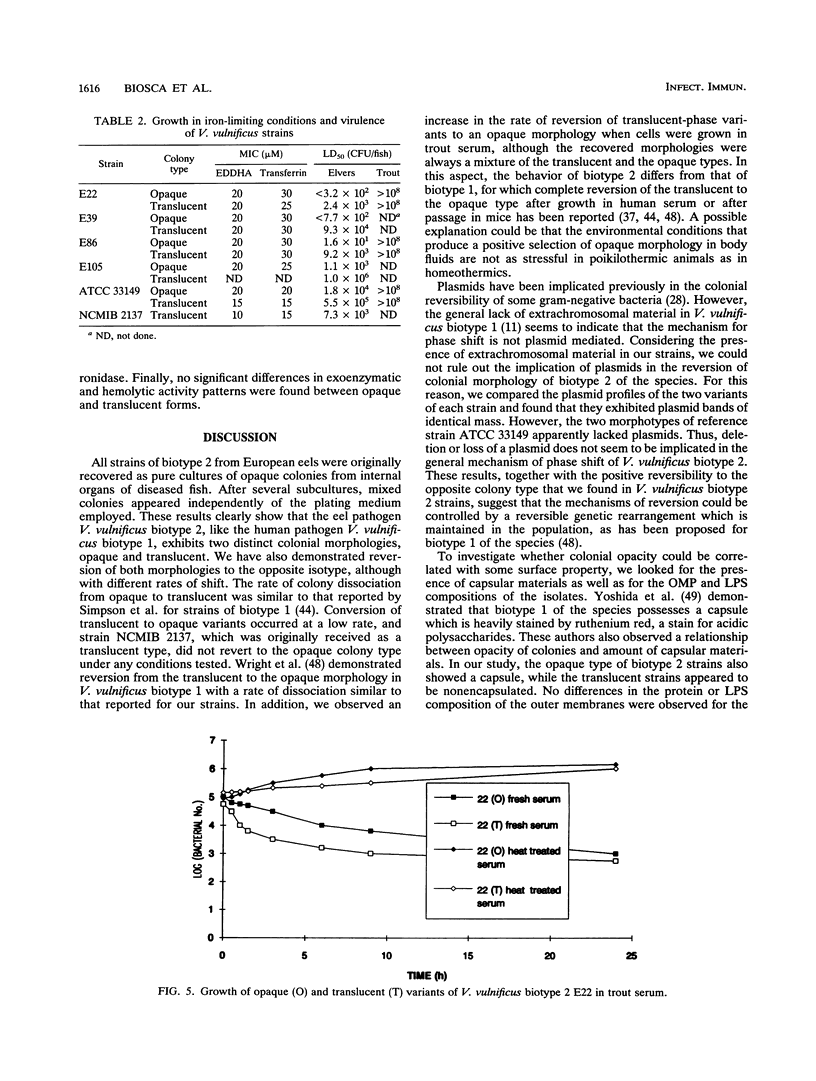
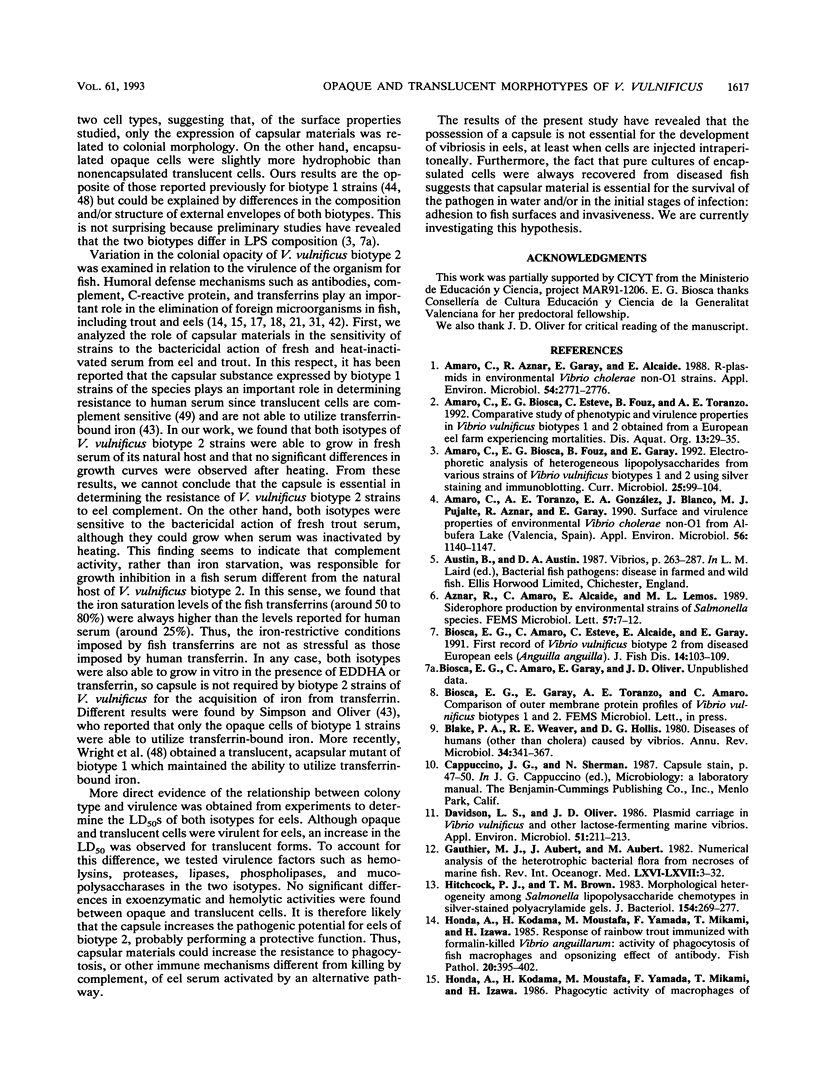
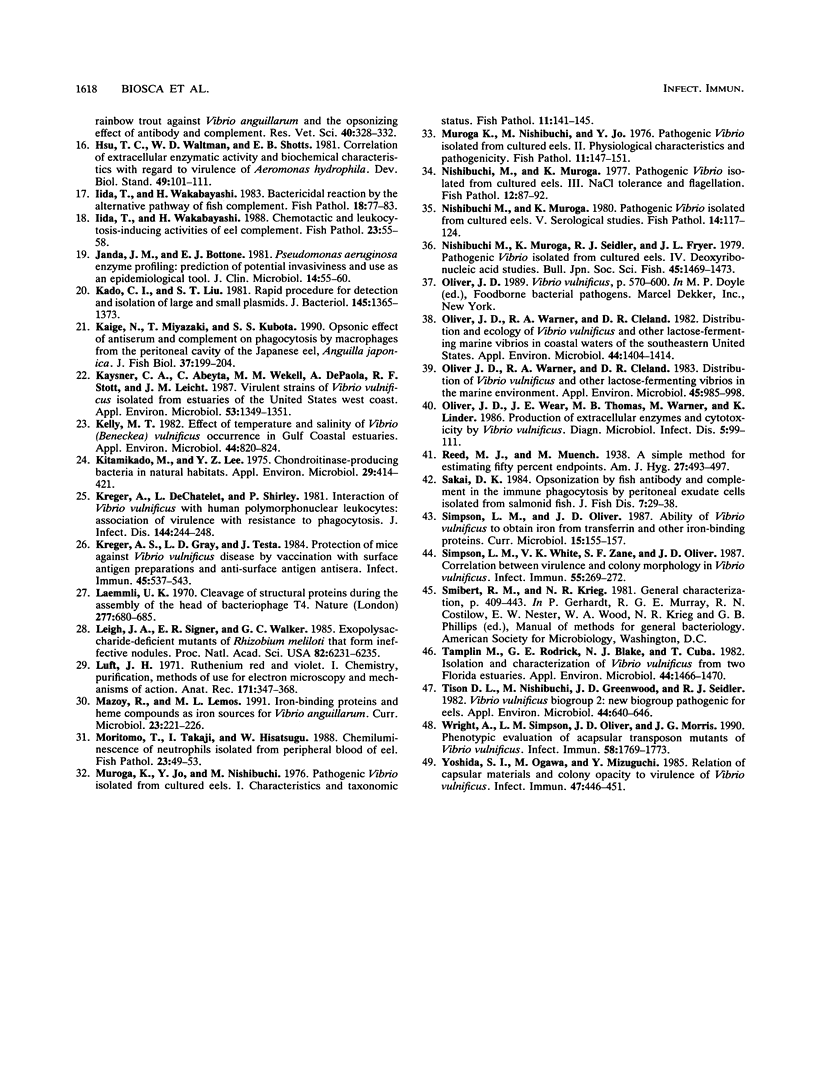
Images in this article
Selected References
These references are in PubMed. This may not be the complete list of references from this article.
- Amaro C., Aznar R., Garay E., Alcaide E. R plasmids in environmental Vibrio cholerae non-O1 strains. Appl Environ Microbiol. 1988 Nov;54(11):2771–2776. doi: 10.1128/aem.54.11.2771-2776.1988. [DOI] [PMC free article] [PubMed] [Google Scholar]
- Amaro C., Biosca E. G., Fouz B., Garay E. Electrophoretic analysis of heterogeneous lipopolysaccharides from various strains of Vibrio vulnificus biotypes 1 and 2 by silver staining and immunoblotting. Curr Microbiol. 1992 Aug;25(2):99–104. doi: 10.1007/BF01570967. [DOI] [PubMed] [Google Scholar]
- Amaro C., Toranzo A. E., González E. A., Blanco J., Pujalte M. J., Aznar R., Garay E. Surface and virulence properties of environmental Vibrio cholerae non-O1 from Albufera Lake (Valencia, Spain). Appl Environ Microbiol. 1990 Apr;56(4):1140–1147. doi: 10.1128/aem.56.4.1140-1147.1990. [DOI] [PMC free article] [PubMed] [Google Scholar]
- Aznar R., Amaro C., Alcaide E., Lemos M. L. Siderophore production by environmental strains of Salmonella species. FEMS Microbiol Lett. 1989 Jan 1;48(1):7–12. doi: 10.1016/0378-1097(89)90137-7. [DOI] [PubMed] [Google Scholar]
- Blake P. A., Weaver R. E., Hollis D. G. Diseases of humans (other than cholera) caused by vibrios. Annu Rev Microbiol. 1980;34:341–367. doi: 10.1146/annurev.mi.34.100180.002013. [DOI] [PubMed] [Google Scholar]
- Davidson L. S., Oliver J. D. Plasmid carriage in Vibrio vulnificus and other lactose-fermenting marine vibrios. Appl Environ Microbiol. 1986 Jul;52(1):211–213. doi: 10.1128/aem.52.1.211-213.1986. [DOI] [PMC free article] [PubMed] [Google Scholar]
- Hitchcock P. J., Brown T. M. Morphological heterogeneity among Salmonella lipopolysaccharide chemotypes in silver-stained polyacrylamide gels. J Bacteriol. 1983 Apr;154(1):269–277. doi: 10.1128/jb.154.1.269-277.1983. [DOI] [PMC free article] [PubMed] [Google Scholar]
- Janda J. M., Bottone E. J. Pseudomonas aeruginosa enzyme profiling: predictor of potential invasiveness and use as an epidemiological tool. J Clin Microbiol. 1981 Jul;14(1):55–60. doi: 10.1128/jcm.14.1.55-60.1981. [DOI] [PMC free article] [PubMed] [Google Scholar]
- Kado C. I., Liu S. T. Rapid procedure for detection and isolation of large and small plasmids. J Bacteriol. 1981 Mar;145(3):1365–1373. doi: 10.1128/jb.145.3.1365-1373.1981. [DOI] [PMC free article] [PubMed] [Google Scholar]
- Kaysner C. A., Abeyta C., Jr, Wekell M. M., DePaola A., Jr, Stott R. F., Leitch J. M. Virulent strains of Vibrio vulnificus isolated from estuaries of the United States West Coast. Appl Environ Microbiol. 1987 Jun;53(6):1349–1351. doi: 10.1128/aem.53.6.1349-1351.1987. [DOI] [PMC free article] [PubMed] [Google Scholar]
- Kelly M. T. Effect of temperature and salinity on Vibrio (Beneckea) vulnificus occurrence in a Gulf Coast environment. Appl Environ Microbiol. 1982 Oct;44(4):820–824. doi: 10.1128/aem.44.4.820-824.1982. [DOI] [PMC free article] [PubMed] [Google Scholar]
- Kitamikado M., Lee Y. Z. Chondroitinase-producing bacteria in natural habitats. Appl Microbiol. 1975 Mar;29(3):414–421. doi: 10.1128/am.29.3.414-421.1975. [DOI] [PMC free article] [PubMed] [Google Scholar]
- Kreger A. S., Gray L. D., Testa J. Protection of mice against Vibrio vulnificus disease by vaccination with surface antigen preparations and anti-surface antigen antisera. Infect Immun. 1984 Sep;45(3):537–543. doi: 10.1128/iai.45.3.537-543.1984. [DOI] [PMC free article] [PubMed] [Google Scholar]
- Kreger A., DeChatelet L., Shirley P. Interaction of Vibrio vulnificus with human polymorphonuclear leukocytes: association of virulence with resistance to phagocytosis. J Infect Dis. 1981 Sep;144(3):244–248. doi: 10.1093/infdis/144.3.244. [DOI] [PubMed] [Google Scholar]
- Laemmli U. K. Cleavage of structural proteins during the assembly of the head of bacteriophage T4. Nature. 1970 Aug 15;227(5259):680–685. doi: 10.1038/227680a0. [DOI] [PubMed] [Google Scholar]
- Leigh J. A., Signer E. R., Walker G. C. Exopolysaccharide-deficient mutants of Rhizobium meliloti that form ineffective nodules. Proc Natl Acad Sci U S A. 1985 Sep;82(18):6231–6235. doi: 10.1073/pnas.82.18.6231. [DOI] [PMC free article] [PubMed] [Google Scholar]
- Luft J. H. Ruthenium red and violet. I. Chemistry, purification, methods of use for electron microscopy and mechanism of action. Anat Rec. 1971 Nov;171(3):347–368. doi: 10.1002/ar.1091710302. [DOI] [PubMed] [Google Scholar]
- Oliver J. D., Warner R. A., Cleland D. R. Distribution and ecology of Vibrio vulnificus and other lactose-fermenting marine vibrios in coastal waters of the southeastern United States. Appl Environ Microbiol. 1982 Dec;44(6):1404–1414. doi: 10.1128/aem.44.6.1404-1414.1982. [DOI] [PMC free article] [PubMed] [Google Scholar]
- Oliver J. D., Warner R. A., Cleland D. R. Distribution of Vibrio vulnificus and other lactose-fermenting vibrios in the marine environment. Appl Environ Microbiol. 1983 Mar;45(3):985–998. doi: 10.1128/aem.45.3.985-998.1983. [DOI] [PMC free article] [PubMed] [Google Scholar]
- Oliver J. D., Wear J. E., Thomas M. B., Warner M., Linder K. Production of extracellular enzymes and cytotoxicity by Vibrio vulnificus. Diagn Microbiol Infect Dis. 1986 Jul;5(2):99–111. doi: 10.1016/0732-8893(86)90112-4. [DOI] [PubMed] [Google Scholar]
- Simpson L. M., White V. K., Zane S. F., Oliver J. D. Correlation between virulence and colony morphology in Vibrio vulnificus. Infect Immun. 1987 Jan;55(1):269–272. doi: 10.1128/iai.55.1.269-272.1987. [DOI] [PMC free article] [PubMed] [Google Scholar]
- Tamplin M., Rodrick G. E., Blake N. J., Cuba T. Isolation and characterization of Vibrio vulnificus from two Florida estuaries. Appl Environ Microbiol. 1982 Dec;44(6):1466–1470. doi: 10.1128/aem.44.6.1466-1470.1982. [DOI] [PMC free article] [PubMed] [Google Scholar]
- Tison D. L., Nishibuchi M., Greenwood J. D., Seidler R. J. Vibrio vulnificus biogroup 2: new biogroup pathogenic for eels. Appl Environ Microbiol. 1982 Sep;44(3):640–646. doi: 10.1128/aem.44.3.640-646.1982. [DOI] [PMC free article] [PubMed] [Google Scholar]
- Wright A. C., Simpson L. M., Oliver J. D., Morris J. G., Jr Phenotypic evaluation of acapsular transposon mutants of Vibrio vulnificus. Infect Immun. 1990 Jun;58(6):1769–1773. doi: 10.1128/iai.58.6.1769-1773.1990. [DOI] [PMC free article] [PubMed] [Google Scholar]
- Yoshida S., Ogawa M., Mizuguchi Y. Relation of capsular materials and colony opacity to virulence of Vibrio vulnificus. Infect Immun. 1985 Feb;47(2):446–451. doi: 10.1128/iai.47.2.446-451.1985. [DOI] [PMC free article] [PubMed] [Google Scholar]



